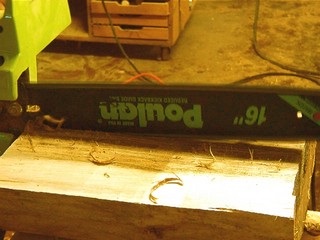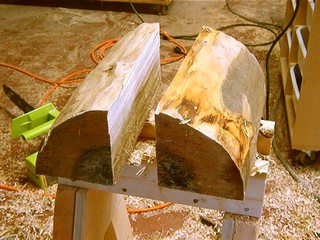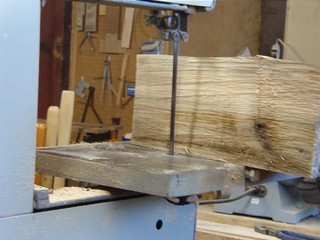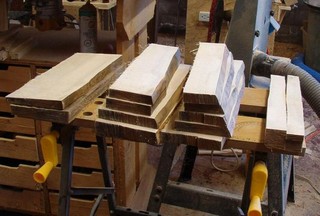
While it has nothing really to do with bowls, this has a lot to do with going from log to lathe. I tend to do a lot of spindle turning, especially for craft shows, so I have decided to cut the other half the log into 3/4" thick boards for spatulas. To start with, I cut the half log down the center with the chain saw. By the way, the saw bar is on correctly. Chain saw bars are symmetrical and I like to flip it every now and then for even wear. I am not sure if it is worth it but I have been doing it for almost fifty years and would have trouble changing now.

This leaves me with two quarter logs to cut into boards for spindle work. Actually, either one or both could be turned as is for larger spindles. The choice is up to you, of course. While the work of cutting boards is in front of me, it is not great and considering the price or hardwood lumber and especially quartersawn hardwood lumber, it is well worth it.

I am going to quarter saw the slices from the log, so I mark from the sides of the log a series of 3/4" lines. Quarter sawn wood is less likely to warp as it dries and sometimes is prettier than plane sawn.

Then I go to the band saw and cut the slices. First I cut from one side, flip and cut from the other. Because the chain saw cut is seldom right on 90 degrees the first cuts are usually not right on the money, but the band saw surfaces are fine from then on. I could do the first cut with the band saw but the chain saw is easier. By the way, I am using a 20 year old Rockwell Beaver band saw with a Tufftooth 3/8" 3 point hook tooth blade which I resharpened myself. It cuts through 4 or 5 inches of wet maple with no problem.

Here we have the finished boards, ready for drying. Those two on the left are the first two side cuts. They are somewhat uneven in thickness but will make some turnings. The ones on the far right should make a couple of spurtles. Middle ones will be stacked for drying and eventually cut for spatulas. I will likely get 13 to 15 spatulas from the pieces. To dry them I just stack them in the shop with popsicle sticks between them for air spacers. The ends are already sealed because the log was sealed on both ends before I started to cut. Next, back to the bowls





